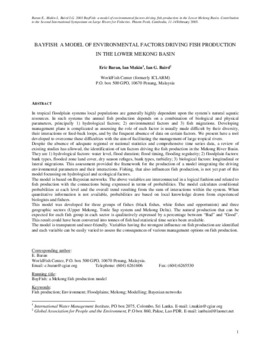Bayfish: a model of environmental factors driving fish production in the lower Mekong basin
Abstract
In tropical floodplain systems local populations are generally highly dependent upon the system’s natural aquatic resources. In such systems the annual fish production depends on a combination of biological and physical parameters, principally 1) hydrological factors; 2) environmental factors and 3) fish migrations. Developing management plans is complicated as assessing the role of each factor is usually made difficult by their diversity, their interactions or feed-back loops, and by the frequent absence of data on certain factors. We present here a tool developed to overcome these difficulties with the aim of facilitating the management of large tropical rivers. Despite the absence of adequate regional or national statistics and comprehensive time series data, a review of existing studies has allowed, the identification of ten factors driving the fish production in the Mekong River Basin. They are 1) hydrological factors: water level, flood duration; flood timing, flooding regularity; 2) floodplain factors: bank types, flooded zone land cover, dry season refuges, bank types, turbidity; 3) biological factors: longitudinal or lateral migrations. This assessment provided the framework for the production of a model integrating the driving environmental parameters and their interactions. Fishing, that also influences fish production, is not yet part of this model focussing on hydrological and ecological factors

